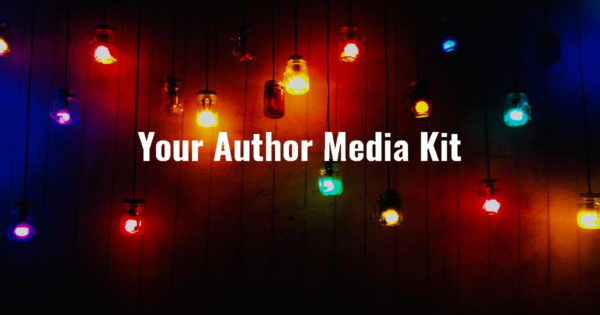
I didn’t even know I was supposed to have a media kit, or press kit, or whatever you want to call it. Did you? Do you even know what one is? I had heard of these things before, but I never really gave them much thought. Until now.
In doing research for a new book release, I discovered that I should not just create a media kit for the release, but it should also be a crucial marketing tool. This is something you can put on your website or have in PDF/print formats to send to local media to give them an idea about who you and your book are all about, and be used at every stage of book marketing from pre-release to beyond.
What is a media kit?
A media kit is a one-stop place for someone to get information about you and/or your book that they can use when promoting you or the book. These kits can focus more on the author or the book with versions available both online and in print form for optimal distribution.
What must be in a media kit?
At a minimum, an author’s media kit should include information about the author. Some authors will write a lengthy bio that can be shortened by whoever needs to use it. But whether your kit is online or in print, I recommend a bio that’s less than 250 words long.
Your headshot should also be here. This headshot should be the same one used across all your platforms rather than having a few here for someone to choose from. This provides consistency across your brand.
A link to your website and social media platforms should be included, even if the kit is located on your website.
Be sure to indicate some means for contacting you. You may include a call-to-action if you wish such as signing up for your newsletter or following you on social media. In summary, a bio, headshot, online links, and contact information are the bare essentials for your author media kit.
You can easily transform this basic media kit into one for an upcoming book release. Include the same information as above, but make it secondary to your presentation. The media kit is now about your book after all.
The only change you’ll want to make from above is reduce your author bio to 75 words or less. You’ll want the cover of your book to be the center of attention with a short blurb about what your book is about (less than 250 words or so). A call-to-action is all but required, often just information on how to purchase the book.
What else can be in a media kit?
A media kit can be spruced up or targeted to certain audiences. If you have some great reviews about your book, add a couple of them to your media kit. If your book won any awards, be sure to mention them.
Different audiences are interested in slightly different information and it’s possible to modify your kit to reflect the targeted audience, whether it be a bookstore, blogger, journalist, or radio host. You’ll probably find this most useful with printed versions of your media kit.
Links to prior interviews given online or in a vlog or podcast may be provided if you wish. The goal is to clearly define your brand as an author with any information that could be used to promote your and/or your book. Just don’t go overboard.
Website and media kit duality
Some of you may have a website with a page dedicated to your book and another that contains information about you. I once believed this was sufficient, with a dedicated media kit seen as redundant. I won’t go so far as to say that you must have a dedicated media kit if you have these pages, but I highly recommend it. It’s nice to have one central location to get all the information needed under one website address, simplifying marketing endeavors. If your media kit hooks them, they’ll be drawn to check out the rest of your website where you are virtually unlimited in what you can say.
Now I suppose I should go finish my own media kit. Happy writing!

Margaret Combs
Thanks. This is great. While I know most of this, the way it is organized makes it very useful. My new and third book will soon be delivered by my publisher and I am preparing to start the media effort. Thanks for the effort.
Patty Perrin
Thank you, Daniel, for this well-organized list of what goes into a media kit. As a new author, I thought putting together a press kit would be complicated, and I had no idea what information they’d want from me. You’ve conquered the dragon, so to speak, and removed the intimidation factor. Would you mind if I share the link to this post from a website that helps other authors? I’ll wait for your reply. Thanks again!
Joan Cochran
Thanks … your timing couldn’t have been better for me. Very useful info. I’ve done them before but needed that little kick in the butt and added info to get moving.
Nancy Christie
You absolutely have to have one even if you have an About the Author page in your site. But it needs to be kept updated. I review mine every month in case there is new info to add. Since I set it up in Word, it’s easy to do. Then I re-save as a pdf and have it as a downloadable file on my website.
Nancy Christie
You absolutely have to have one even if you have an About the Author page in your site. But it needs to be kept updated. I review mine every month in case there is new info to add. Since I set it up in Word, it’s easy to do. Then I re-save as a pdf and have it as a downloadable file on my website. Easy peasy